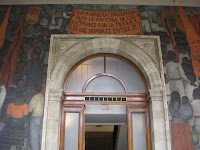On Saturday I participated (watched more then anything) in the process of building a tinaco (water cistern) with a group of about 14 men in Chiaucingo, a community 15 minutes from Olinala. This is one of the appropriate technologies that MCC has implemented in the region.
The process is a two day event: Day one is the assembly of the mold for the floor and the walls; Day 2 is the placement of the roof. Typically, MCC works with the group to build one, then the trained group, who are well versed in construction, build the rest.

The ground level, the mold is ready to be assembled.

All of the mold pieces are numbered for easy assembly.




Assembling the outside mold by securing the fastener.

The last piece of the outside mold is in two parts to facilitate easy assess to the inside.

Learning how to place the metal fencing for the floor.

Reinforcement for the floor.

Metal fencing is placed for the floor and walls.

Clipping the fencing that is too high.

Pouring the cement floor.

They have to mix their own cement - cement, fester (a sealer), gravel, sand and water.

Everyone has their role in the cement mixing process.
By the end of the day they were pretty efficient.


Bucket by bucket, the cement floor is poured.


Intently watching the process.

Passing the cement needed for the floor.

Manuel is training him how to use the level for the floor.

The last piece of the outside mold is placed and secured.

With a level and metal piece in the middle as a guide, the cement floor is leveled.

Hanging on the metal fencing on the side to ensure a floor without footprints.

Enjoying chicken at 9:00am and waiting for the floor to dry.

The breakfast dishes not yet clean, the preparation for lunch begins.
Preparing the mole for lunch after the walls are poured.

After a two hour break, the floor is suffieciently dry to be able to place the inside mold.

Assembling the inside mold. All the pieces are numbered with arrows so there is no confusion.

A solution is painted on to the molds so that the cement does not stick to the molds. It makes it easier to remove the molds at the end.

Assembling the inside mold.

It is really important that all of the ganchos (fasteners) are secured on the mold so that it does not move when the cement is poured.

Once the inside mold is assembled, they move the mold so that the walls were uniform.

Metal bars, which will be removed, are used to reinforce for the mold for when the cement walls are poured.

The metal bars reinforce the mold as the cement poured for the walls could move the mold.

Touch ups on the floor so that it is smooth when everything is completely dry.

Ready to pour the cement for the walls.

On day 2, the inside mold is removed.
Inspecting their good work.

The mold is removed and the walls are cleaned and sealed to prevent future leakage.

The last step - the roof of the tinaco. The Coke can marks the place for the roof water to enter. The cistern will be ready for use in about a week.













































